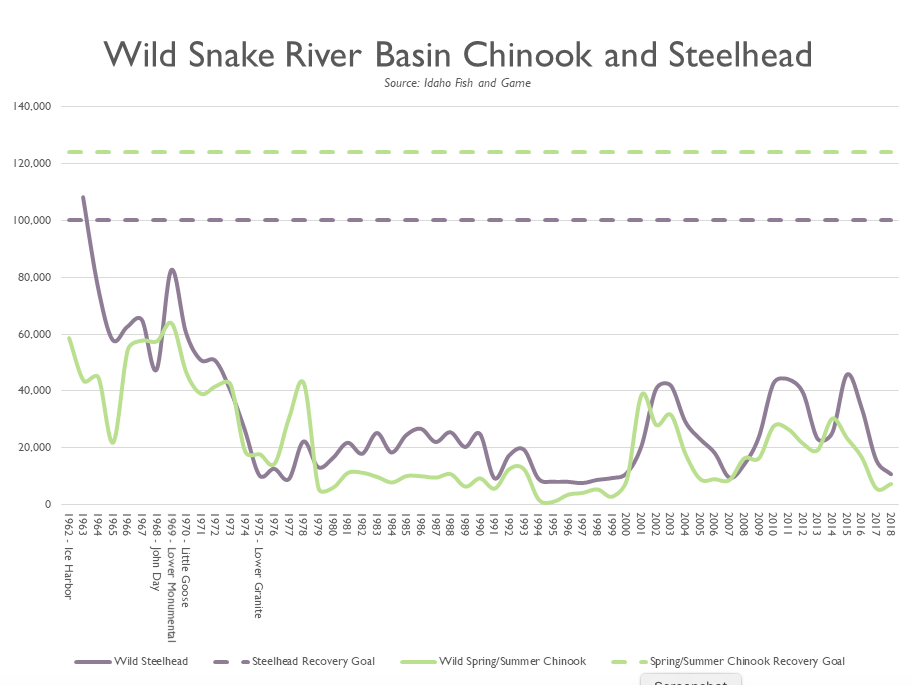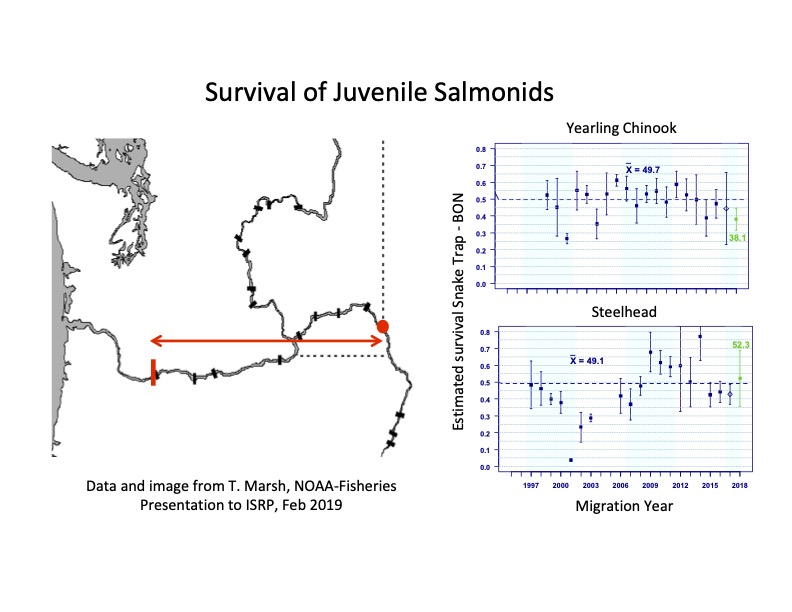forum
library
tutorial
contact

Fishing Guide Hopes to Engage
Idahoans on Salmon Solutions
by Jerry Painter
Post Register, October 29, 2019
|
the film forum library tutorial contact |

|
Fishing Guide Hopes to Engage
by Jerry Painter
|
 It's not working.
It's not working.
So far, all the tactics, strategies, programs and billions of dollars to keep Idaho's salmon and steelhead returning each year have been ineffective. In the past few decades, fish numbers have gone from the millions to the thousands. The crash has been particularly acute in the past few years.
In 2018, steelhead fishing seasons were shut down on the Main Salmon and Clearwater river systems. This year, the steelhead season was shut down once again on the Clearwater River. Only 13 wild sockeye salmon returned to Idaho in 2018. Salmon and steelhead numbers are at 2 percent of their original populations.
"Essentially, if we don't act now, wild salmon and steelhead may go extinct within a generation," said Scott Ki, communication associate for the Idaho Conservation League.
Last week, the Idaho Conservation League hired Emerald LaFortune as campaign outreach assistant for salmon and steelhead recovery. Her task is to engage Idahoans in their communities across the state on the issue of recovering wild salmon and steelhead.
"I'm always up for a good challenge," LaFortune said. "I think the strategy is multifaceted. If there's one simple, easy solution, we would have gotten there already. I think right now it's about making sure that Idahoans are informed on the issue and making sure that Idahoans know how to use their voice and their story and leadership in their own communities to make sure that this topic is at the front of everyone's mind throughout the basin."
LaFortune, of Salmon, has been working as a fishing guide and heading up the Redside Foundation since 2016, a nonprofit that supports the health and strength of Idaho's guiding community.
The crash of Idaho's iconic fish has risen to the forefront in recent weeks with two Northwest tribes demanding that three major hydroelectric dams be removed on the Columbia River to save migrating salmon and starving orcas and restore traditional fishing sites. Backing up the tribes, more than 50 scientists signed a letter and sent it to Northwest policymakers last week calling for the four lower Snake River dams to be breached to counteract warm summertime water that can be lethal to salmon and steelhead.
Idaho Gov. Brad Little kicked off a series of workgroups this year across the state involving representatives from industry, conservation, sportsmen, state and local leaders and various other stakeholders tasked with finding solutions that will restore salmon and steelhead in the state.
 "We need innovative thinking and bold action to bring them back to healthy, abundant levels throughout the Snake Basin," Little said.
"We need innovative thinking and bold action to bring them back to healthy, abundant levels throughout the Snake Basin," Little said.
LaFortune, who holds an environmental studies and nonprofit administration degree from the University of Montana, said she is optimistic about the process of pulling Idahoans together to find solutions. She admits that the evidence against dams, especially those on the lower Snake River, as salmon and steelhead killers is hard to refute.
"We need to be a little uncomfortable and have these tough conversations to move the ball forward on this issue," she said. "The best available science tells us that our salmon and steelhead are going extinct in part because of the four lower Snake River dams downstream in Washington. It's what the science says. The other element is that the Bonneville Power Administration is approaching some huge shifts and facing major financial and repair issues in the next decade."
Tearing down dams is not the most popular solution for communities, such as Lewiston, that are economically tied to dams. Lewiston the West's most inland port and Idaho's only seaport.
The supply of cheap electricity in the Northwest could also be in affected.
"There are folks that benefit from grain being barged through those reservoirs on the lower Snake," LaFortune said. "Lewiston is a town that's built around the four lower Snake River dams."
LaFortune said she is hopeful that by bringing all the stakeholders together, solutions can be reached.
"I think that there are opportunities to think in a way that we can bring back salmon-steelhead and figure out a way to reshape the Northwest energy system in a way to protect low rates for rate payers," she said. "We work on it so that everyone gets what they need, whether it's Idaho water users, farmers, barge operators or the towns throughout the system."
The importance of restoring salmon and steelhead goes deeper than protecting an economy of fishing estimated at hundreds of millions of dollars a year.
"As a guide, even when you aren't actively steelhead or salmon fishing, that story and that legacy is part of the mystique and interest of a place like Idaho," LaFortune said. "People come to our state on outfitted trips because they have a chance to see what the landscape looked like when Lewis and Clark were here. When I was guiding, I would always remind people that it doesn't look like when Lewis and Clark were here if we don't have salmon and steelhead in these rivers."
learn more on topics covered in the film
see the video
read the script
learn the songs
discussion forum
